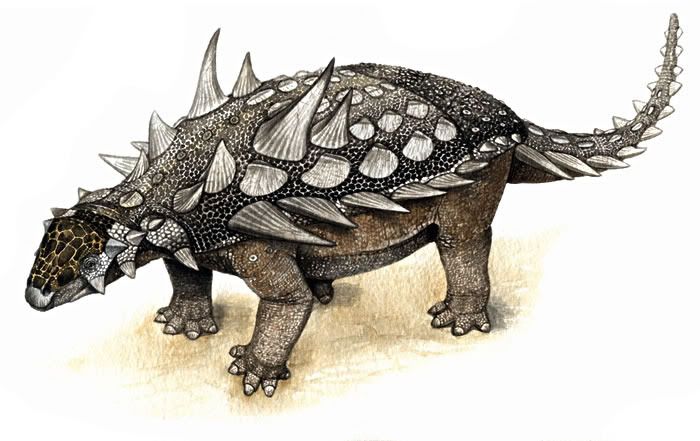Gastonia was a (gas-toh-nee-ah) ankylosaurid dinosaur and they were built like a tank. Gastonia stood three feet tall and was between 13 and 16 feet long, and weighed about one ton. His entire body was covered by bony plates and spikes of different shapes and sizes. You wouldn't want to pet him!
He has lots of heavy armor so he moves slow. He had poor eyesight (bet he wishes he had glasses or a magnifying glass) but a strong sense of smell and hearing (sneaking up on him would not be easy). He has a solid bony plate over its hips, which allowed him to crouch down to protect his vulnerable stomach from attacking predators. The spikes covering his body and the spikes on his tail were used like "chainsaws" as offensive weapons to protect itself from an attacking predators like Utahraptor.
Gastonia lived in the USA, North America in the early Cretaceous Period (142-127 million years ago) and Gastonia was a plant-eater. One of Gaston neighbor was a predator named Utahraptor. Talk about neighbors who don't get along! Eeeeep!!!!
Gastonia was named after paleontologist Robert Gaston. He made the first discovery of Gastonia fossilized remains in Moab, Utah, in 1989. Thank you Robert Gaston!
He has lots of heavy armor so he moves slow. He had poor eyesight (bet he wishes he had glasses or a magnifying glass) but a strong sense of smell and hearing (sneaking up on him would not be easy). He has a solid bony plate over its hips, which allowed him to crouch down to protect his vulnerable stomach from attacking predators. The spikes covering his body and the spikes on his tail were used like "chainsaws" as offensive weapons to protect itself from an attacking predators like Utahraptor.
Gastonia lived in the USA, North America in the early Cretaceous Period (142-127 million years ago) and Gastonia was a plant-eater. One of Gaston neighbor was a predator named Utahraptor. Talk about neighbors who don't get along! Eeeeep!!!!
Gastonia was named after paleontologist Robert Gaston. He made the first discovery of Gastonia fossilized remains in Moab, Utah, in 1989. Thank you Robert Gaston!















0 comments:
Post a Comment